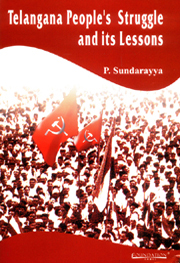Book contents
- Frontmatter
- Contents
- Preface
- Introduction
- PART I
- PART II
- 1 Entry of Indian Army and Immediately After
- 2 Terror Regime and Resistance
- 3 The Krishna Forest (Nallamala) Region
- 4 The Godavari Forest Region
- 5 Actions of Guerrilla Squads
- 6 People's Upsurge in Karimnagar and other New Areas
- 7 Movement in Cities and of the Working Class
- 8 Struggle Inside Jails
- 9 Women in the Telangana Movement
- 10 Brief Sketches of Some of the Squad and Party Leaders: after the Entry of the Indian Army
- 11 Withdrawal of Telangana Armed Partisan Resistance
- Epilogue
- PART III
11 - Withdrawal of Telangana Armed Partisan Resistance
from PART II
Published online by Cambridge University Press: 05 November 2011
- Frontmatter
- Contents
- Preface
- Introduction
- PART I
- PART II
- 1 Entry of Indian Army and Immediately After
- 2 Terror Regime and Resistance
- 3 The Krishna Forest (Nallamala) Region
- 4 The Godavari Forest Region
- 5 Actions of Guerrilla Squads
- 6 People's Upsurge in Karimnagar and other New Areas
- 7 Movement in Cities and of the Working Class
- 8 Struggle Inside Jails
- 9 Women in the Telangana Movement
- 10 Brief Sketches of Some of the Squad and Party Leaders: after the Entry of the Indian Army
- 11 Withdrawal of Telangana Armed Partisan Resistance
- Epilogue
- PART III
Summary
The peasantry and the people of Telangana, since long, had been struggling against the forced labour, illegal exactions, evictions by the feudal landlords, deshmukhs and jagirdars. The struggle was directed against the autocratic regime of the Nizam Nawab of Hyderabad, against the oppression of his bureaucratic officials such as the village patels, patwaris and the other revenue and police officers, and against the suppression of the mother-tongue of the Telugu-Marathi and Kannada-speaking people in the State. There were demands for elementary democratic rights and civil liberties such as the right of freedom of speech, assembly and press, and also for setting up a responsible government in the State, in the place of the dictatorial personal rule of the Nizam Nawab.
But this struggle of the Telangana people assumed a different, radical and militant character, when the leadership of the Andhra Mahasabha passed into the hands of the Communist Party and its cadres, during the year 1943. The peasant struggle in Telangana, thereafter, had steadily acquired the character of an agrarian revolt, finally raising the slogans for the abolition of landlordism, for the overthrow of the Nizam's autocratic rule, for the liquidation of the princely State of Hyderabad and for the merger of the different language-speaking peoples into the new States of Visalandhra, Samyukta-Karnataka and Maharashtra. The Telangana peasant struggle which initially began as self-defence with lathis and slings against the goonda attacks of the deshmukhs and Razakars and the atrocities of the police forces of the Nizam Nawab, had culminated in an armed liberation struggle against the princely state of Hyderabad.
- Type
- Chapter
- Information
- Telengana People's Struggle and it's Lessons , pp. 293 - 326Publisher: Foundation BooksPrint publication year: 2006

